-
Posts
2,792 -
Joined
-
Last visited
Content Type
Profiles
Forums
Gallery
Events
Articles
Posts posted by bill
-
-
1893 Aluminum
Ada Rehan So-Called Dollar
Hibler & Kappen 767
44.5 mm, AU
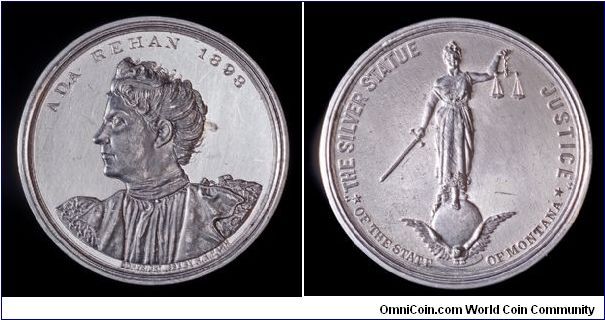
The obverse depicts Ada Rehan left, with the inscription ADA REHAN 1893. Incused, below the bust is COPYRIGHT 1893 BY R.H. PARK. Ada Rehan (1860 - 1916) was born Ada Crehan in Limerick, Ireland. She debuted on the American stage in Philadephia at age 14. A program spelling error led to her satge name, Rehan. She became popular in New York and London for her Shakespearan roles.
The reverse shows a statute of justice standing on a globe on an eagle with the inscription, THE SILVER STATUE OF JUSTICE / OF THE STATE OF MONTANA.
Hibler and Kappen list the medal in their American Personalities section and propose it was issued to commemorate an appearance in Montana. The medal should probably be listed among the World's Columbian medals. Richard Henry Park, sculptor, chose Ada Rehan as the model for a silver and gold sculpture commissioned for the Montana exhibit at the Exposition. The statue announced Montana as a major player in gold and silver mining.
The statue illustrated by C Graham for Scenes from the 1893 World's Fair The Columbian Exposition (see http://washingtonmo.com/1893/index2.htm).
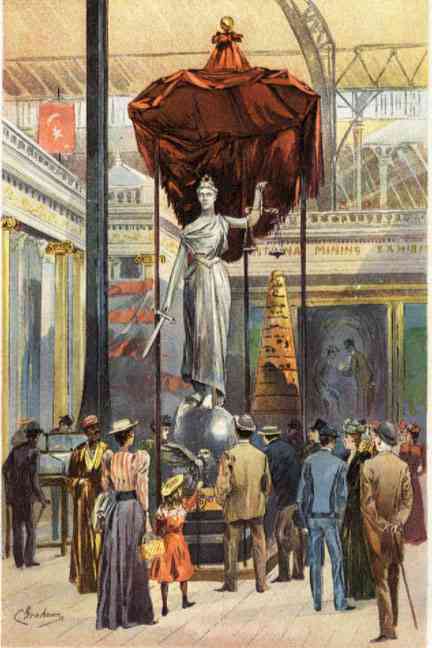
A description of the exhibit in the Book of the Fair:
But the centre of attraction is Montana’s beautiful pavilion, at the entrance of which stands a case of specimens from the Elkhorn district, is the statue of Justice, fashioned of native silver, and with orthodox scales and sword. In this statue, placed under a canopy of maroon velvet, in the centre of the pavilion, and guarded by two bronze lions, was used nearly a ton of sterling silver, the figure resting on a silver globe, beneath which is an eagle with outstretched wings. The lower portion of the pedestal is of ebony, and upon this is a plinth of pure gold, more than two feet square, and representing, as is said, a value of $250,000. The model selected for this, the largest silver statue in the world, was the actress Ada Rehan, whose stately and opulent form is cast in heroic mold. Behind the statue is a structure fashioned of copper bars; on the walls the more prominent mining centres are reproduced in photographs, and at the back a painting, named A Good Strike, represents the scene which its title indicates.
And a photograph from the Library of Congress:

-
The World's Columbian Exposition commemorated the 400th anniversary of the discovery of America. Expositions had a profound impact on the country as well as European nations. Ethnographic "villages" introduced the public to other cultures and other ways of life long before television brought the world into your home. The debates as to whether the impacts promoted understanding or racism will never be resolved. Many of the "displays" went on to become side-shows that travelled the country. The exposition was important from my collecting perspective by the rich array of aluminum medals and tokens produced as souvenirs. Many of these are cataloged as so-called dollars.
My favorite is the topic of the first entry in this thread.
1892 Aluminum
Liberty Head Dollar / Landing of Columbus
Hibler & Kappen 222
36mm Proof (with original card box of issue)
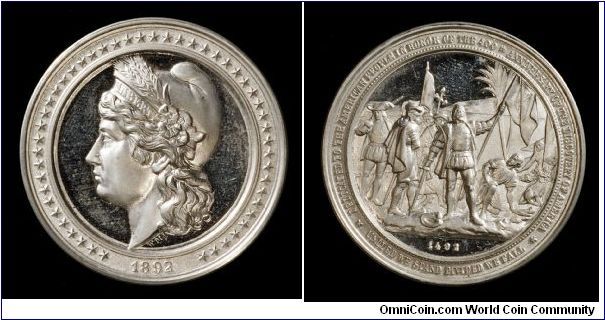
I'm following H&K in showing the Liberty Head as the obverse in a ring of stars with 1892 below. The medal's engraver, Adolph Weyl of Germany, described the Liberty head as the reverse. The initials, W.M. appear on the base of the bust. Compare the portrait to George Morgan's Liberty on the silver dollar. I assume WM is for Wilhem Mayer, the German company that produced the medal.
The reverse shows the landing of Columbus with 1492 below and the legend, DEDICATED TO THE AMERICAN PEOPLE IN HONOR OF THE 400TH ANNIVERSARY OF AMERICAN / UNITED WE STAND DIVIDED WE FALL.
The medal is proof and came with the original card box of issue. Hibler and Kappen indicate that it is very scarce (251 - 500), but I've seen 4 or 5 other nice proof examples on Ebay in the past year. One graded by NCG for a registry set was listed at $1,900, but most seem to run in the $150 to $300 range. The medal was first shown at the Italo-American Exposition in Genoa, Italy.
-
Political tokens served a variety of purposes such as propaganda in your pocket and reminders to vote, and they also served to legitimize campaign donations at political rallies. The turmoil of post World War I Germany brought on by the economic crises and multiple failed governments contributed to the rise of increasingly radical and agressive political parties of which the NSDAP was only one. One law meant to lower the level of conflict forbid parties from collecting donations at political rallies on the theory that restricting the flow of donations would help weaken the influence of the parties. They responded with a variety of ways to continue the cash flow, typically relying on the sale of items such as postcards, pamphlets, etc. Sales of things were legal. The NSDAP sold donation tokens and the tokens shown in the previous posts could well have been donation tokens as well. A series of tokens specifically identify themselves as being donation tokens, some with specific values.
An unusual brass token commemorates the act of voting itself in the 1932 Reichstag election. The obverse features a swasstika buried in a sea of raised hands perhaps indicating it was issued after the July election when the NSDAP scored its largest vote. The artist's stylized signature reads GHM or GMH depending on the order in which the letters are meant to be read. The reverse reads "1932 Reichstag Election, Campaign Donation, Never Capitulate."
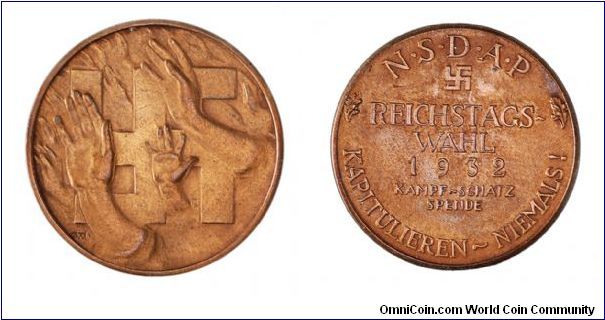
-
Not all election tokens featured Hitler. The April 24, 1932 Prussian state elections were held following Hindenburg's ban of the SA and SS military arms of the NSDAP. Military units of other political parties were banned as well, but the real intention was controlling the violence perpetrated by the Nazis. Perhaps an answer to Hindenburg (or maybe just evidence of the problem), the Prussian arm of the party issued a militant aluminum token. The obverse pictures a nude male slaying a three-headed snake. The reverse declares "Fight lies, deceit, and treason. Action liberates. Vote List 8, April 24, 1932." The darkened area below the snake is damage from some sort of tape attached to the token at some point in the past.
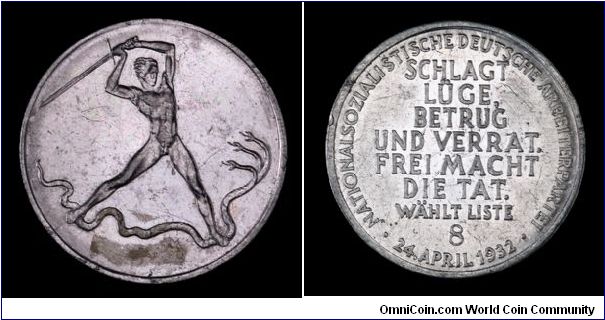
-
Yes, they are aluminum. I should have included that!
-
German political events and social conditions of the post World War I period produced a rich array of exonumia. I became interested in the political tokens in the 1970s as I was researching the catalog, Medallic Portraits of Adolf Hitler (co-authored with R.W. Colbert, published by the Token and Medal Society, 1981). I'll post a few of the Hitler portrait tokens and some related tokens to expand on the discussion about Hitler and von Hindenburg started in thread initiated by Goetzdude and his spectacular Goetz medals. The tokens are not of the same artistic quality, but they are historically important nonetheless.
The earliest election token dates to the 1928 Reichstag election. The token urges the recipient to vote for List 12. The candidates in Reichstag elections appeared on ballots as a slate of candidates. List 12 meant the NSDAP was the 12 slate on the ballot. The number of candidates elected was a product of the propostion of votes the slate received. Only the first 4 candidate names appeared on the ballot with the List number. The obverse Identifies Hitler as the part leader, the leader out of the hardship. The reverse slogan, we want to pave the road to freedom for the German worker, is rather long and complicated for the party's propaganda philosophy. That slogan would change on tokens issued for future elections.
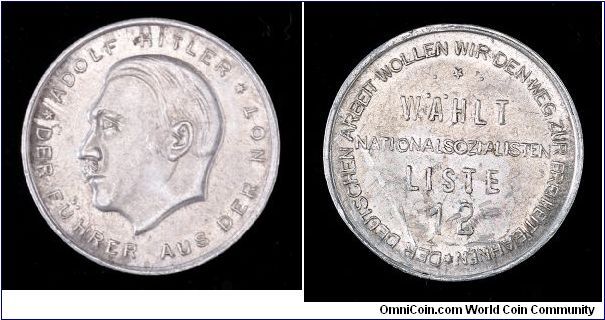
The second token was issued for the 1932 presidential election. The presidential elections were for individuals, hence the "Vote Adolf Hitler." Hitler polled 37% of the vote. Hindenburg was elected with 53%.
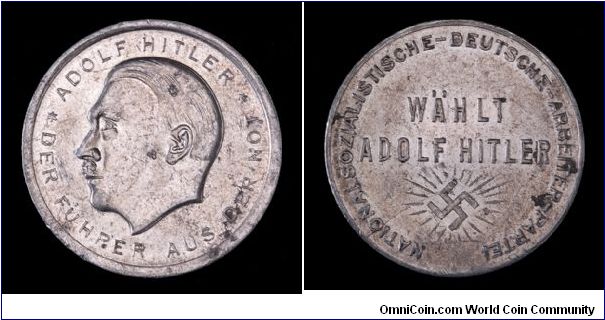
The third token commemorates the success of the 1930 Reichstag elections heading into the 1932 elections. The Nazi party received a plurality of the vote and became the largest party in the Reichstag. It did not, however, receive a majority and that prompted to political maneuverings discussed in the Goetzdude thread about Hitler's appointment as Reichs Chancellor. The token may have promoted the July or the November 1932 elections. The NSDAP retained its pluraity in November, but lost ground. The reverse shows the eagle and swastika and the 1928 to 1932 vote totals. The inscriptions promote "Freedom and Bread" and "Now More Than Ever." This particular token is from the John Ford collection. He "liberated" a few Hitler medals from the party headquarters (the Brown House) in Munich and that began his collecting interest. His collection was sold at auction by Bowers and Ruddy in 1983. I reviewed the collection during the cataloging phase and later purchased two election tokens in the auction.
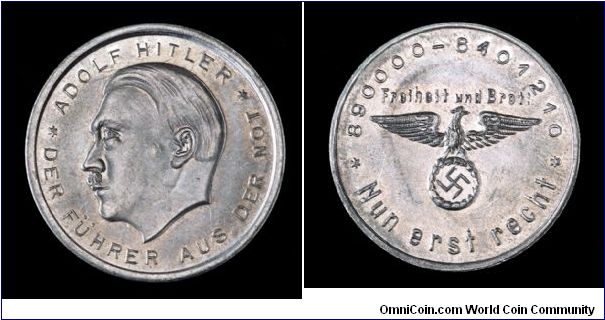
We cataloged 12 different tokens in this political series. One of the twelve featured a more naturalistic portrait, the other 11 share the same obverse portrait. Others varieties may exist as much of this material was destroyed after the war during de-Nazification efforts.
-
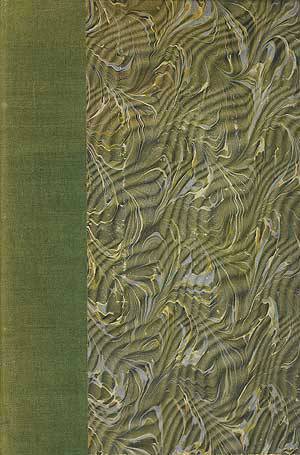
My latest purchase arrived today. From the seller's description:
Heiss, Aloïs. Description générale des monnaies antiques de l'Espagne. Paris, L'Imprimerie Nationale, 1870. 548 pp., 68 ppl. of line drawings. Quarterbound cloth with marbled boards. Fine, spine a bit faded. No to very minimal foxing.
An early standard work on Celtiberian and Romano-Spanish coinages, still often cited. Employs thick paper with large margins and specially designed Iberian/Phoenician fonts, includes valuations in Francs, and the line drawings are nothing less than superb.
It was described as massive (9.5" by 12.5", 3" thick), about 10 pounds. The paper feels wonderful and the type has an amazing raised texture. The custom fonts are nothing short of superb and the illustrations are spectacular. I never seize to be amazed by the quality of the line drawings from the 1800s.
An added bonus, not in the dealer's description, is the bookplate of the eminent numismatist, Doct. Pierre Bastien. A note in E-sylum describes the bookplate as: appropriately, in the form of a coin, the obverse bearing the image of a woman (Cleopatra?) feeding a snake, the reverse with comic and tragic masks, a scroll and a pen upon a manuscript. Bastien wrote French catalogs of the Roman coins of Lugdunum (among other books). While I do not yet own any of his books (they are on my library want list), I now own a spectacular book from his personal library. I love these personal ties to the numismatic community.
-
1791 12 Heller, Aachen.
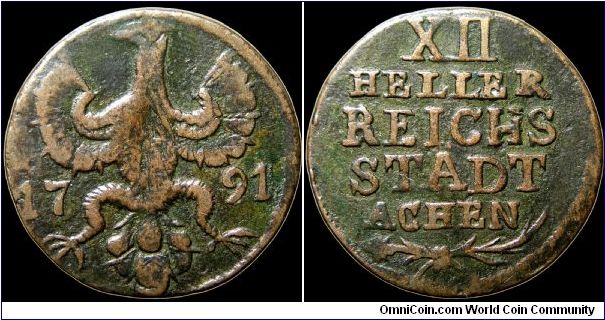
That dead duck(???) looks ready to be plucked!

(Nice acqusitions.
 )
) -
I've picked up a few token books in the last few weeks, Latin American Tokens by Russell Rulau, Tokens of Mexico by Frank Grove, and a signed and numbered copy of A Guide to Colorado Merchant Trade Tokens by Stuart Pritchard. Standard fair to expand my library in support of my aluminum collection (and just because I like numismatic books).
But the best find was Thai Coins by Mark Graham and Manfred Winkler, 1992, Finance One Limited, Bangkok, Thailand. It is a beautifully illustrated survey of the history of Thai coins published in Thai and English. The coins and various monetary forms used through time are all illustrated with the best examples from private collections, many of them extremely rare and not commonly encountered by Western collectors. Although I do not collect Thai coins, I could not pass this beautiful volume that I encountered in our local used bookstore.
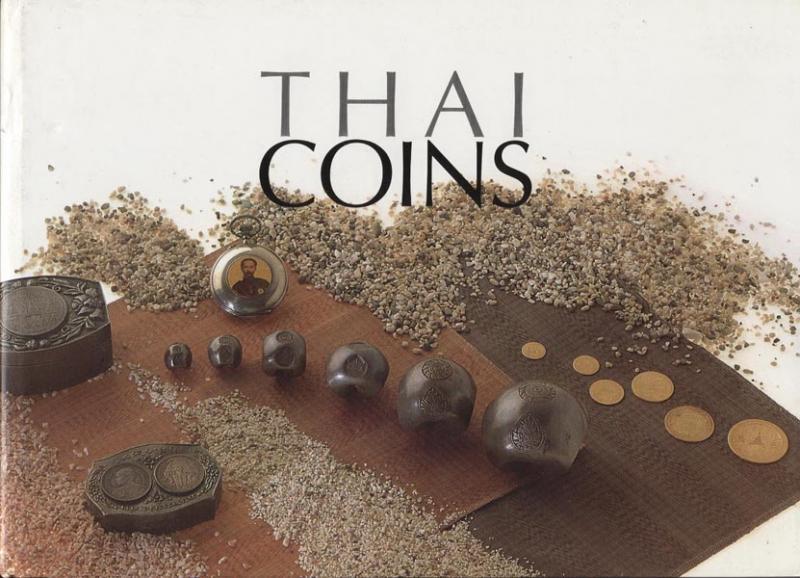
-
For the most part, toning is not my thing. I agree that well developed attractive toning is something that might draw one to a coin. However, its not something I seek out one way or another. That 1883 nickel on the other hand could seriously spoil me. That is one beautiful coin!
-
The one day San Francisco Historical Bourse was held today. Only about 14 dealers, but all specializing in ancients and it seemed busy all day long. I hope the dealers had a good day so that it gains in strength. The two day show typically held this time of year had slowly collapsed.
In addition to two coins, I cam home with two books:
The Barbaric Tremissis in Spain and Southern France Anastasius to Leovigild by Wallace J. Tomasini (ANS Museum Notes and Monographs, 152 -- 1964). I don't own any of these coins and have been tempted from time to time. Now I can learn something about them.
The second book I've scanned from time to time lusting after the quality of the photography, so I broke down today and bought one:
Roman Coins by J.P.C. Kent with photographs by Max and Albert Hirmer. (Abrams 1978).
-
Thank you! Great coins, fun contest.
-
I commented on the Latvian coin in your other post and the freedom of modern artists in how they treat the coin as medium. Your Polish commemoratives intrigue me for the consistent style or manner in which they use the positive and negative aspects of the coin's field to create a strong design. The amber inset, albeit totally impractical for a circulating coin, adds a touch to the obverse that knocks my socks off. Great coin.
-
I visited Sydney years ago and wandered into what was the Sydney mint museum or a national coin collection. The early Australian pieces are fascinating. Great collector pieces.
-
Is there a way to decide whether he is facing left or right (typical die alignment) or is that an arbitrary choice?
Those with full heads face left, so one must assume these face left. But, I'm tempted to rotate it to a big smiley face!

-
A brief description of Potins (cast coins, cast much like Chinese cash coins on casting trees and the spur is often left where the coin was detached -- evident at 12 and 6 on the second coin, at 9 on the third, and 11 and 5 on the last can be found at this commercial site:
Brief Introduction to Celtic Potins of Gaul
The first two heads on the left side of the text page are early stages of my "big smiley face." The crescent is the back of the head. The eye, nose, and chin have been reduced to dots.
-
Four new additions over the past few months:
From the Parisii, ca 50 B.C. Schematic head or skull obverse, swastika reverse. Extremely rare.
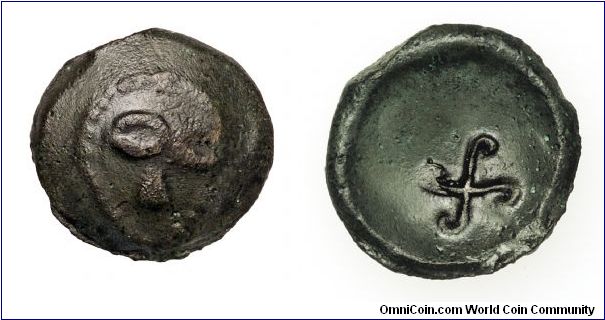
From the Aulerques Éburovices, ca 60 - 50 B.C. Almost all known potins of this type were found in or near a Celtic temple. The obverse is a highly stylized head (a degenerated version of a design that is clearly a head). The reverse is a wild boar. Extremely rare type.
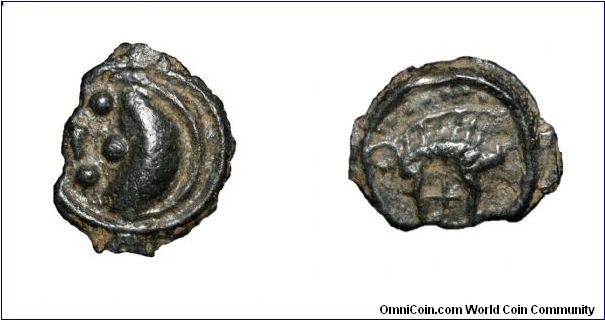
The following two are PIXTILOS types (10 classes of designs in total). I've managed to collect 6 of the ten classes, although one is poorly preserved. I'm also collecting the Roman Republican prototypes for each class.
From Carnutes, ca. 40 - 30 B.C., Class II. The obverse is a female head with the legend PIXTIL. The reverse image is a lion and lizard. Rare
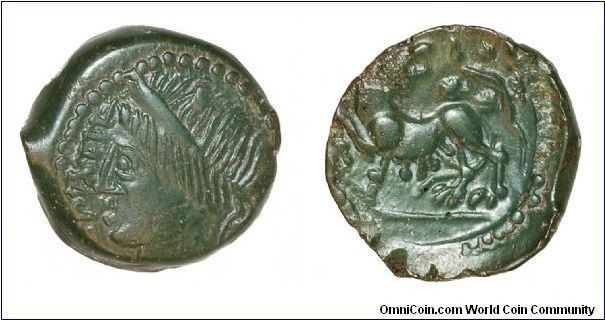
From Carnutes, ca. 40 - 30 B.C., Class V. The obverse is a male head with the legend PIXTIL. The reverse features a seated figure with geometric designs. Very rare.
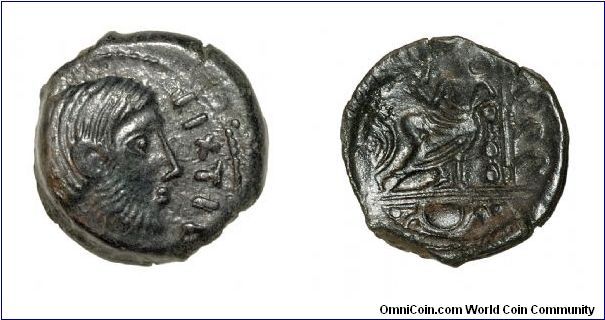
-
My second purchase arrived today, A California Gold Rush History featuring the treasure from the S. S. Central America by Q. David Bowers, inscribed and signed. I love his books and I needed another 11 pounds to balance the 10 Roman Imperial Coins volumes that will be arriving next.
Just to show its not all about coins, I also received a first edition (rebound) copy of Ramsy's 1853 History of Tennessee. It has the earliest reference to my Hyder lineage that I know of in print. Michael Hyder was a Wataugan, one of the earliest settlements in eastern Tennessee. His house, built pre-revolutionary war survives to this day. He made gun powder that helped arm the rebels that fought the British in the Revolutionary War and fought himself with the Over Mountain Men (think in a very general way about the farmer fighters portrayed in The Patriot). Danial Boone negotiated the purchase of their land from the Cherokee and Davy Crocket's grandfather and Michael fought together defending their homes from Cherokee attack a few days before the war officially began after they refused to side with the British (they were west of the line that defined the colonies and therefore on their own). I could go on, but I haven't figured out what would form a colonial era east Tennessee coin collection as yet. Its an idea that bounces around the back of my head every now and then.
-
I got my tax refund and bought some books (and some coins!). The first arrived today:
The publisher's blurb is at:
http://www.signature-book.com/New2Books/burdette.htm
This is the first (actually the third) of three planned volumes (1905-1908 and 1909-1915 will complete the trio) on the redesign of American coins from 1905 through 1921. I no longer collect American coins, but this caught my eye. It doesn't seem to be well known and I find that a little puzzling. It seems to be well done at first glance. I've only sampled through it so far, but I'm impressed with what I've read so far. Its worth a look if you collected Liberty walkers, standing liberty quarters, mercs, or Peace dollars.
-
I sold my only large cent to joanjet, but I'm enjoying your cents Art. I could get hooked myself if I didn't have my other interests. You just might inspire me to return to US collecting some day.
-
I decided to revamp and update this thread beyond the three coins I originally posted. The comments that follow refer to the unedited version of the post. Rather than start a new thread, I thought I would edit and expand with the previous comments intact. I've deleted two images that will reappear in new entries below.
"Three recent purchases to share (December through February).
The first dates to about 970 and is either an issue of Thibaut the Trickster (ca. 957 to 978) or it is a bit later and is an issue of Eudes I (ca. 978 to 996). A design of this type was found in the Fecamp hoard. The coin is extremely rare (probably less than 5 known)."
So:
Denier, Blois
Thibaut the Trickster
ca. 957 - 978
Legros 928v
Roberts 5054v
Duplessy 573
Dumas 6928v
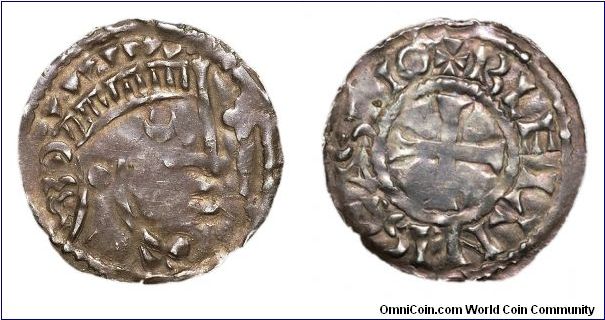
The County of Blois held an important position in medieval France situated in the midst of extensive fertile agricultural lands. In 940, Thibaut the Trickster, founder of the House of Blois, assumed the title of Count and built the infrastructure to protect the populace from the invading Bretons and Normans. By 987, the Counts of Blois were poised as rivals of the Capétiens. The family was intimately tied to the Capétians and the royal lineage. Thibaut's mother was the sister of Eudes king of France (888-897). Eudes himself had been count of Blois and Anjou, abbot of St. Martin of Tours, and count of Paris. Her other brother, Robert, was king of France from 922-923. His son, Hugh the Great, was father of Hugh Capet, the first of the Capétian line of French kings.
-
Manuel de Numismatique Francaise, IV, Monnaies Feodales Francaises
by A. Dieudonne (Editions Auguste Picard, Paris. 1936)
Numismatique Medievale
by Marc Bompaire and Francoise Dumas (Brepols, Turnhout, Belgium. 2000)
Not many pictures and I don't read French! Slow going, but I use them as references in research and translate what I need as I need it. Time for me to retire and take a French class.
-
I like the 1901 Prussian commemorative. I owned one once in proof. The detail is incredible. I eventually sold it (along with a few other coins) to buy a 1942/41 dime. It wasn't anywhere near proof or even AU, more like VF, but I think I enjoyed that coin even more. The overdate is so dramatic! Alas, it too has passed on for someone else to enjoy.
Great coins!
-
Did Count Stephen Henry or Count Theobald IV of Blois have any coinage? I definately need to get some coinage of that era especially for such a distingushed family. I also need to get down to Winchester Cathedral to pay a visit to a certain someone.
Count Theobald IV of Blois is likely represented by the coins of Châteaudun, specifically Poey d'Avant 1829, Caron 116, Caron 119 or one of the many varieties of deniers or obols of this type. The coins are issued without legend as to ruler, so the attribution is determined by the proposed date of the type (based on hoards) and who was count at the time. I've include an obverse image of a denier below.




World's Columbian Exposition 1892-93
in Exonumia Virtual Museum
Posted
1893 Aluminum
Michigan Forestry Exhibit So-Called Dollar
Hibler & Kappen 214
38 mm Unc
The obverse depicts a log cabin from a Michigan logging camp (an example of an ethnographic exhibit mentioned in an earlier post). Legends above the cabin read, WORLD’S FAIR, below CHILDS CHICAGO / 1893. The surrounding ring reads, MICHIGAN FORESTRY EXHIBIT / LOGGING CAMP. Childs, Chicago indicates the company producing the medal.
The reverse shows a load of logs on a horse-drawn sled with the legends above CHAMPION LOAD OF LOGS. Below 36055 FEETWEIGHT 144 TONS / DRAWN BY EST. OF / THOMAS NESTOR. Thomas Nestor established a mill in Pequaming in 1879, adding another nearby. His firm grew to include a shipping fleet on Lake Superior. The World's Fair Load of Logs, 36,055 feet, was hauled by Thomas Nester's crew to Ontonogan River, Michigan on February 26, 1893. They exhibited the load in Chicago at the World's Fair as the largest load of logs ever hauled in the world and hauled by one team. Height of load 33 feet 3 inches, weight of logs 144 tons. Sled teams routinely competed for such drinking honors at the end of the day.
An early book (digital version at Library of Congress, American Memory), Between the iron and the pine; a biography of a pioneer family and a pioneer town, describes the process:
On the skidways were small piles of logs to be hauled out on the big sleighs to the rollways on the river bank, where they would await the spring drive. The sleighs used to haul the great loads of logs were from eight to ten feet wide at the double runners and shod with inch-thick steel. Twelve and fourteen cross beams or bunks were fastened across the sleigh with "king bolt" in the middle in order that the bunks could be swung back lengthwise on the return trip so that sleighs could pass each other more easily at the "turn-outs." The sleighs were drawn to the side of the skidways and the logs were rolled onto the bunks, at first by the loading and decking crew with canthooks, then as the pile became higher, decking chains were placed around the middle of the logs and the logs pulled onto the high load with horses. The entire load was bound by chains at each end and was ready to go. The teamster climbed to the top and drew up his reins. Again speaking quietly to his horses, the driver reined his team to the right to "break" the runners. Then straightening the animals out for a forward pull, he eased them into their collars. Digging their sharp-shod feet into the ice and snow, the horses started the load. Once the load, weighing from ten to fifteen tons at times, gathered momentum, it did not stop until the rollway was reached.
Each teamster endeavored to haul a record load. There was spirited competition and lively small betting between the drivers. In the bunkhouse each crew bragged about the loads hauled during the day.
The passage later describes the honored event:
The largest load of logs ever hauled out of the woods consisted of 36,055 feet of virgin Michigan pine. The logs averaged eighteen feet in length. The height of the load was thirty-three feet and three inches. The weight was one hundred and forty-four tons. This load was decked by a chain and a team of horses. It was hauled by a team on iced roads to the Ontonagon river, then rafted in the spring to the nearest railroad where it was loaded onto nine flatcars and shipped to the Chicago World's Fair to be used in buildings there. As many a forty million feet of logs were taken out of the woods by one outfit in one season.
The load was immortalized in a historic photograph: